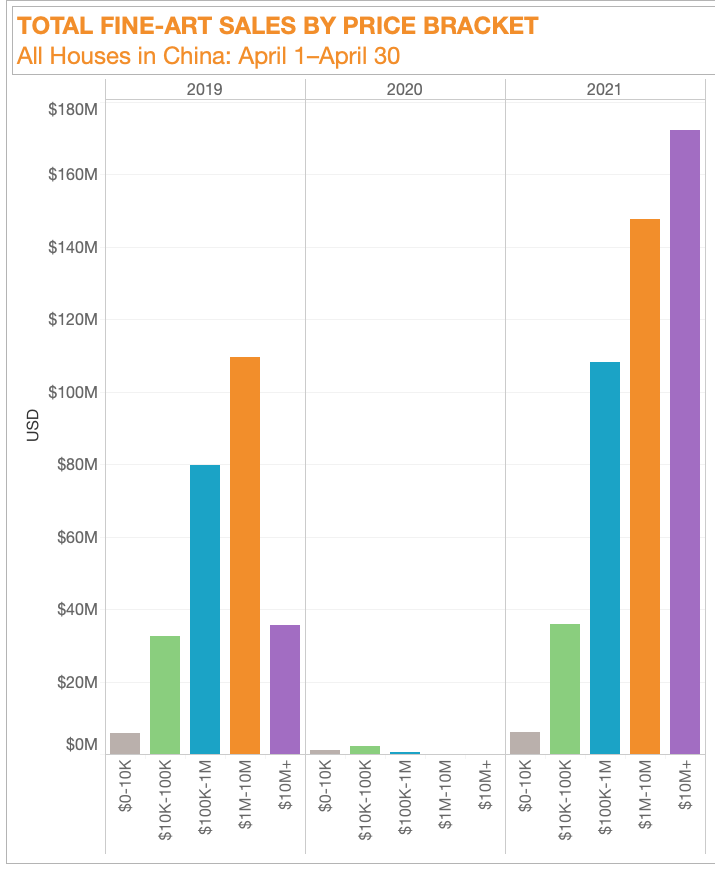Artnet News Pro
What Is Driving Hong Kong’s Latest Auction Boom? Our Data Provides an Answer
We read the tea leaves in data from the Artnet Price Database to give you a sense of what's in store.

We read the tea leaves in data from the Artnet Price Database to give you a sense of what's in store.

Julia Halperin

Last month was a very good one for the Chinese art market. The country sold $470 million worth of art at auction in April, up a whopping 12,062 percent from the same month in pandemic-plagued 2020, and up 78.6 percent from April 2019.
These figures are particularly encouraging as the region heads into its next big test: the return of Art Basel Hong Kong (which is underway as you read this) and Christie’s sales of 20th and 21st century art at the end of May.
(Remember last week, when we told you that we’d have a better sense of exactly where the country’s auction market stands when data from April came in? Well, now we do.)
A closer look at the numbers provides a window into exactly which segments of the market are most buoyant in Hong Kong—and where the biggest opportunities lie. Read on for answers.

© Artnet Analytics.
– Our data—which includes auction sales in both Hong Kong and mainland China—shows that the top of the market is growing fastest. In April 2019, only two lots sold for $10 million or more in China; that number quintupled, to 10, in April 2021.
– Works priced at $10 million-plus represented the largest slice of the market last month in China, bringing in $172 million. Artists who fell into this category include Chinese painters with Western crossover appeal like Chu Teh-Chun and Zao Wou-Ki, as well as Western blue-chippers like Pablo Picasso, Gerhard Richter, and Clyfford Still.
– Other sectors of the market also demonstrated growth. Sales in the $100,000-to-$1 million price bracket, as well as in the $1 million-to-$10 million bracket, were up approximately 35 percent each compared to April 2019. Both of these segments tend to appeal to buyers who are newer to the market and younger than those active in the uppermost echelon, according to art-world insiders.
– N.B.: We’re not bothering to compare this year’s numbers with April 2020, when just four works sold at auction for more than $100,000. It was not a good moment!
– We have two explanations, a macro one and a logistical one. First, the macro one: Rich people have gotten quite a bit richer over the past year, if you hadn’t heard. China alone minted more than 250 billionaires in 2020—around five per week—bringing its total to 878, according to wealth-tracker the Hurun Rich List. (The U.S. is home to around 650.)
– Now, the logistical explanation: Sotheby’s moved its major Hong Kong sales from March to April this year, which is a big reason that April 2021 so handily eclipsed April 2019. But regardless of the timing, Sotheby’s spring Hong Kong sale series was still up from 2019, when it brought in $482 million compared to this year’s $496 million.
– The best place to sell major masterpieces may still be the United States, as evidenced by the solid performance of the May evening auctions at Christie’s and Sotheby’s in New York last week. But below the surface, we can sense some tectonic plates shifting, with more consignors and buyers demonstrating a willingness to transact in Asia at the highest level.
– Our reporting has shown that, over the past year, younger Asian buyers interested in fresh, new international names have started to make major ripple effects in the market. But don’t count their parents out just yet: Blue-chip art—which tends to appeal to an older generation—still carries the biggest prices in the business, even if there might be thinner demand for it.
– Looking ahead, keep an eye on Christie’s Hong Kong sales series from May 20 to May 28. We just might find out which generation is willing to spend more on art.